美国宾夕法尼亚州立大学陈功教授学术报告会
不容错过的课题申报经验分享~~

不容错过的课题申报经验分享~~故事⾃述类我的国家社科项⽬申报之路分享⼈分享⼈::刘国兵刘国兵,河南师范⼤学校聘教授、硕⼠⽣导师,学校语料库应⽤研发中⼼学术带,河南师范⼤学校聘教授、硕⼠⽣导师,学校语料库应⽤研发中⼼学术带头⼈。
研究⽅向为语料库语⾔学及应⽤语⾔学。
内容选摘内容选摘::参加⼯作以来,项⽬申报已经成为了家常便饭。
“谋事在⼈,成事在天”,申报时好好论证,最后成与不成,结果并不重要。
所以“麦⼦不收年年种”,这是梁晓冬教授(河南师范⼤学外国语学院院长,时任科研副院长)给学院青年教师⿎⽓时经常说的⼀句话。
这些年来,我也确实把这句话记在了⼼⾥。
每到项⽬申报季节,从项⽬选题到填写表格,⼀轮⼀轮论证,总是忙得不亦乐乎。
因为⼼⾥想着,不管麦⼦收不收,先种了再说。
毕竟,学会了播种,收获只是时间的问题。
我的课题申报之路分享⼈:分享⼈:陈功,博⼠,对外经济贸易⼤学英语学院副教授、硕⼠⽣导师。
研究⽅向为语料陈功,博⼠,对外经济贸易⼤学英语学院副教授、硕⼠⽣导师。
研究⽅向为语料库语⾔学、应⽤语⾔学。
内容选摘:作为语⾔研究者,我们要对⾝边的语⾔现象保持⾼度敏感。
语⾔在我们的⽣活中⽆所不在,深⼊关注这些语⾔现象,或许会给我们带来不⼀样的灵感。
当然,语⾔现象只是表象,要想把它做成⼀项研究,还需要理论和⽅法论。
有了理论,我们的想法才能得到最充分的解释;有了⽅法,我们的做法才能得到最科学的指导。
这就说到了我的选题之所以有可能被专家们认可的另外⼀个要素:系统的科研训练。
我的科研项⽬申报之路何佳佳,美国宾⼣法尼亚州印第安纳⼤学博⼠,美国雪城⼤学尤提卡学院助理教,美国宾⼣法尼亚州印第安纳⼤学博⼠,美国雪城⼤学尤提卡学院助理教分享⼈:分享⼈:何佳佳授,现为对外经济贸易⼤学英语学院教师。
研究⽅向为英语写作研究、⼆语教学法、商务英语研究。
内容选摘::内容选摘我的科研项⽬申报之路并⾮⼀帆风顺,但最终我的学术专业背景、英语写作教学和辅导经验、科研⼯作积累等重要因素帮助我获得了2017年度教育部⼈⽂社科项⽬⽴项。
科研训练报告心得
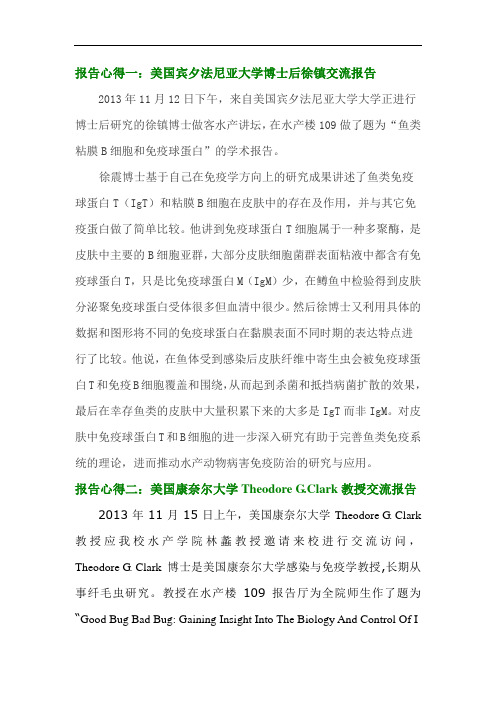
报告心得一:美国宾夕法尼亚大学博士后徐镇交流报告2013年11月12日下午,来自美国宾夕法尼亚大学大学正进行博士后研究的徐镇博士做客水产讲坛,在水产楼109做了题为“鱼类粘膜B细胞和免疫球蛋白”的学术报告。
徐震博士基于自己在免疫学方向上的研究成果讲述了鱼类免疫球蛋白T(IgT)和粘膜B细胞在皮肤中的存在及作用,并与其它免疫蛋白做了简单比较。
他讲到免疫球蛋白T细胞属于一种多聚酶,是皮肤中主要的B细胞亚群,大部分皮肤细胞菌群表面粘液中都含有免疫球蛋白T,只是比免疫球蛋白M(IgM)少,在鳟鱼中检验得到皮肤分泌聚免疫球蛋白受体很多但血清中很少。
然后徐博士又利用具体的数据和图形将不同的免疫球蛋白在黏膜表面不同时期的表达特点进行了比较。
他说,在鱼体受到感染后皮肤纤维中寄生虫会被免疫球蛋白T和免疫B细胞覆盖和围绕,从而起到杀菌和抵挡病菌扩散的效果,最后在幸存鱼类的皮肤中大量积累下来的大多是IgT而非IgM。
对皮肤中免疫球蛋白T和B细胞的进一步深入研究有助于完善鱼类免疫系统的理论,进而推动水产动物病害免疫防治的研究与应用。
报告心得二:美国康奈尔大学Theodore G.Clark教授交流报告2013年11月15日上午,美国康奈尔大学Theodore G. Clark 教授应我校水产学院林蠡教授邀请来校进行交流访问,Theodore G. Clark博士是美国康奈尔大学感染与免疫学教授,长期从事纤毛虫研究。
教授在水产楼109报告厅为全院师生作了题为“Good Bug Bad Bug: Gaining Insight Into The Biology And Control Of Ichthyophthirius Using Tetrahymena As A Basic Research Tool”的学术报告。
Clark教授首先系统地向大家介绍了多子小瓜虫生活史中不同阶段的转录组学研究,指出该研究发现了高丰度转录本都具有阶段特异性,并且与对应生活阶段的代谢特性一致,该研究结果也为后期多子小瓜虫生活史的研究以及药物靶标和候选疫苗的筛选奠定了重要基础。
高效液相色谱法测定丙烯酸酯单体竞聚率

高效液相色谱法测定丙烯酸酯单体竞聚率陈功;魏秀贞;黄鹏程【期刊名称】《北京理工大学学报》【年(卷),期】2001(21)5【摘要】为避免聚合体系中单体之间以及单体与聚合物之间分离困难 ,采用液相色谱法测定了甲基丙烯酰氧乙基三甲基氯化胺 (MTC)与丙烯酸乙酯 (EA)及甲基丙烯酸甲酯(MMA)的竞聚率 .为减少误差 ,根据两种估算法处理实验结果 .在60℃甲醇溶液中 ,测得EA/MTC竞聚率 r1为 1.32 ,r2 为 2 .4 3及 MMA/MTC竞聚率 r1为 0 .98,r2 为 1.【总页数】5页(P658-662)【关键词】甲基丙烯酰氧乙基三甲基氯化胺;丙烯酸乙酯;甲基丙烯酸甲酯;竞聚率;高效液相色谱法;药物控释高分子材料【作者】陈功;魏秀贞;黄鹏程【作者单位】北京理工大学化工与材料学院;北京航空航天大学材料学院【正文语种】中文【中图分类】R318.08;O657.72【相关文献】1.丙烯酸酯-第二单体A共聚竞聚率的测定及其应用 [J], 李学东2.高效液相色谱法测定食品接触材料中丙烯酸酯类单体的迁移量 [J], 李成发;李英;廖文忠;陈旭辉;孙小颖;李泳涛;白爽3.聚乙二醇二甲基丙烯酸酯整体柱固相萃取-高效液相色谱法测定血清中卡马西平和10-羟基卡马西平 [J], 李娜;陈雪蕾;张磊;张倩影;安壮壮;孙鑫;王曼曼;徐厚君4.聚[2-(丙烯酰氧基)乙基]三甲基氯化铵-乙二醇二甲基丙烯酸酯整体柱固相萃取结合高效液相色谱法测定尿液中3种苯二氮类药物 [J], 杜梨; 李娜; 刘美琨; 王翰云; 张倩影; 王曼曼; 王学生5.高效液相色谱法测定聚甲基丙烯酸酯食品材料中甲基丙烯酸酯及甲基丙烯酸向模拟食品液的迁移量 [J], 万富;李阳广;柳阿芳;赵金尧因版权原因,仅展示原文概要,查看原文内容请购买。
脑功能修复新突破-大脑在体重编程再生神经元
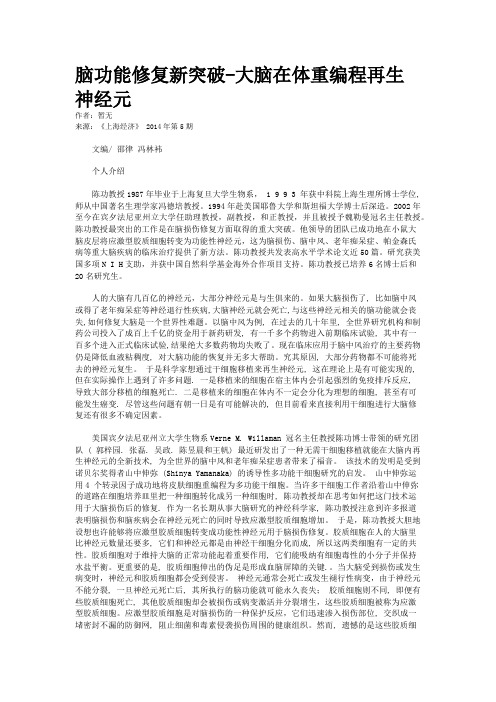
脑功能修复新突破-大脑在体重编程再生神经元作者:暂无来源:《上海经济》 2014年第5期文编/ 邵律冯林袆个人介绍陈功教授1987年毕业于上海复旦大学生物系, 1 9 9 3 年获中科院上海生理所博士学位, 师从中国著名生理学家冯德培教授。
1994年赴美国耶鲁大学和斯坦福大学博士后深造。
2002年至今在宾夕法尼亚州立大学任助理教授,副教授,和正教授,并且被授予魏勒曼冠名主任教授。
陈功教授最突出的工作是在脑损伤修复方面取得的重大突破。
他领导的团队已成功地在小鼠大脑皮层将应激型胶质细胞转变为功能性神经元,这为脑损伤、脑中风、老年痴呆症、帕金森氏病等重大脑疾病的临床治疗提供了新方法。
陈功教授共发表高水平学术论文近50篇。
研究获美国多项N I H支助,并获中国自然科学基金海外合作项目支持。
陈功教授已培养6名博士后和20名研究生。
人的大脑有几百亿的神经元,大部分神经元是与生俱来的。
如果大脑损伤了, 比如脑中风或得了老年痴呆症等神经退行性疾病,大脑神经元就会死亡,与这些神经元相关的脑功能就会丧失,如何修复大脑是一个世界性难题。
以脑中风为例, 在过去的几十年里, 全世界研究机构和制药公司投入了成百上千亿的资金用于新药研发, 有一千多个药物进入前期临床试验, 其中有一百多个进入正式临床试验,结果绝大多数药物均失败了。
现在临床应用于脑中风治疗的主要药物仍是降低血液粘稠度, 对大脑功能的恢复并无多大帮助。
究其原因, 大部分药物都不可能将死去的神经元复生。
于是科学家想通过干细胞移植来再生神经元, 这在理论上是有可能实现的, 但在实际操作上遇到了许多问题. 一是移植来的细胞在宿主体内会引起强烈的免疫排斥反应,导致大部分移植的细胞死亡. 二是移植来的细胞在体内不一定会分化为理想的细胞, 甚至有可能发生癌变. 尽管这些问题有朝一日是有可能解决的, 但目前看来直接利用干细胞进行大脑修复还有很多不确定因素。
美国宾夕法尼亚州立大学生物系Verne M. Willaman 冠名主任教授陈功博士带领的研究团队 ( 郭梓园. 张磊. 吴政. 陈昱晨和王帆) 最近研发出了一种无需干细胞移植就能在大脑内再生神经元的全新技术, 为全世界的脑中风和老年痴呆症患者带来了福音。
葡萄酒色斑光热治疗和光动力学治疗的研究进展
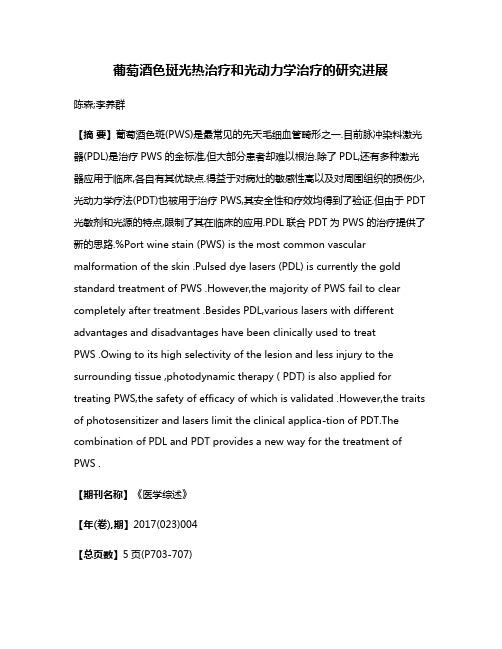
葡萄酒色斑光热治疗和光动力学治疗的研究进展陈森;李养群【摘要】葡萄酒色斑(PWS)是最常见的先天毛细血管畸形之一.目前脉冲染料激光器(PDL)是治疗PWS的金标准,但大部分患者却难以根治.除了PDL,还有多种激光器应用于临床,各自有其优缺点.得益于对病灶的敏感性高以及对周围组织的损伤少,光动力学疗法(PDT)也被用于治疗PWS,其安全性和疗效均得到了验证.但由于PDT 光敏剂和光源的特点,限制了其在临床的应用.PDL联合PDT为PWS的治疗提供了新的思路.%Port wine stain (PWS) is the most common vascular malformation of the skin .Pulsed dye lasers (PDL) is currently the gold standard treatment of PWS .However,the majority of PWS fail to clear completely after treatment .Besides PDL,various lasers with different advantages and disadvantages have been clinically used to treatPWS .Owing to its high selectivity of the lesion and less injury to the surrounding tissue ,photodynamic therapy ( PDT) is also applied for treating PWS,the safety of efficacy of which is validated .However,the traits of photosensitizer and lasers limit the clinical applica-tion of PDT.The combination of PDL and PDT provides a new way for the treatment of PWS .【期刊名称】《医学综述》【年(卷),期】2017(023)004【总页数】5页(P703-707)【关键词】葡萄酒色斑;激光;光动力学【作者】陈森;李养群【作者单位】中国医学科学院整形外科医院整形二科,北京 100144;中国医学科学院整形外科医院整形二科,北京 100144【正文语种】中文【中图分类】R62葡萄酒色斑(port-wine stain,PWS)是由毛细血管畸形导致的先天性疾病。
陈功教授解读 2017NCCN 指南:左右半结肠癌之争 终入指南

陈功教授解读2017NCCN 指南:左右半结肠癌之争终入指南2016 年11 月23 日,NCCN 在线发布了2017 版结肠癌和直肠癌临床实践指南,和2016 年V2 版对比,还是出现了很多能改变临床实践的更新,尤其关于左右半结肠的问题,由于以指南的形式第一次推荐将原发瘤部位纳入mCRC 一线治疗中靶向药物的选择参考依据,这必将是里程碑式的更新,相信也会是引起轩然大波的更新。
以下是笔者对2017 版NCCN 结直肠癌指南的可能会改变临床实践的主要更新做一解读。
早期结直肠癌根治术后建议服用低剂量阿司匹林作为「癌症二级预防」措施2017 版NCCN 结直肠癌指南在「结肠癌长期随访保健计划」(PRINCIPLES OF SURVIVORSHIP - Colorectal Long-term Follow-up Care)章节的「生活方式和健康咨询」栏目里更新了推荐,「考虑低剂量阿司匹林」,并在指南最后的「讨论」文字稿部分专门增加了一个章节,「结直肠癌术后生存患者的二级化学预防」,来阐述早期结直肠癌患者根治术后推荐口服低剂量阿司匹林的相关内容。
关于阿司匹林的防癌与抗癌效果,已经关注了很多年,既往主要研究集中在结直肠肿瘤领域,关注阿司匹林在结直肠癌化学预防领域的两大作用:减少健康人群中CRC 的发生率(一级预防);减少罹患CRC 者根治术后的肿瘤复发(二级预防);而阿司匹林在结直肠癌二级预防的价值,最有名的证据来自哈佛大学麻省总院(MGH)著名学者陈志辉(Andrew CHAN)领导的研究小组的发现,他们在2012 年发现阿司匹林对结肠癌术后复发的预防可能与PIK3CA 基因突变有关,该研究结果发表在当年的新英格兰医学杂志(Liao, X 等,NEJM 2012),引发了全球对此的研究热潮。
2015 年荷兰莱登大学(Leiden University)医学院在欧洲癌症大会(ECC)上公开报到的最新研究结果显示(M. Frouws, 2015 ECC Ab#2306),癌症确诊后常规服用阿司匹林能显著改善来源于整个消化道癌症,尤其是结直肠癌患者的生存情况。
结肠癌辅助治疗突破进展-轰动全球

结肠癌辅助治疗突破进展-轰动全球结肠癌辅助治疗突破进展,轰动全球!这研究结果,还真是结肠癌辅助治疗的重磅炸弹啊……记者丨Joy来源丨医学界肿瘤频道如果说美国临床肿瘤学会(ASCO)和欧洲肿瘤内科学会(ESMO)一年一度的学术大会是全球肿瘤学界的“两会”,那么由中国临床肿瘤学会(CSCO)联合ASCO共同举办的Best of ASCO(BOA)event in China绝对是我国临床肿瘤学者自己的饕餮盛会,也是每年盛夏里的一块学术绿荫。
今儿会议第一天,《医学界》记者就在现场感受到了极其热烈的学术讨论氛围。
在胃肠肿瘤专场的报告中,中山大学附属肿瘤医院陈功教授和浙江大学附属邵逸夫医院潘宏铭教授主要围绕今年ASCO上万众瞩目的焦点——IDEA研究进行了详细的分析评述。
随后的讨论环节,更有解放军八一医院全军肿瘤中心秦叔逵教授、中山大学肿瘤防治中心院长徐瑞华教授发表精彩观点,内容绝对有料!IDEA研究为啥这么火?首先,IDEA研究坐拥全球12个国家1w+例超大样本量,成为迄今为止肿瘤学领域最大样本数的前瞻性荟萃分析,在胃肠肿瘤领域几乎是空前绝后。
其次,IDEA研究对结肠癌现行标准辅助治疗发起了挑战,为3个月DFS HR<1.12。
主要研究结果:·3个月治疗组的DFS为74.6%,6个月治疗组为75.5%,绝对差值仅为0.9%。
预计DFS HR=1.07(95%CI 1.00-1.15),超过预设边界值1.12,非劣效不成立。
·3个月治疗组比6个月治疗组的依从性更高:FOLFOX DFS HR=1.16 (95%CI 1.06-1.26) ;CAPOX DFS HR=0.95 (95% CI 0.85-1.06) 。
·3个月治疗组相关神经毒性较6个月治疗组低2倍以上:FOLFOX(17% vs 48%);CAPOX(15% vs 45%)。
IDEA临床专家共识:低危人群推荐3个月辅助化疗,高危人群推荐6个月辅助化疗,同时考虑患者耐受性、个人意愿、复发风险以及药物方案(CAPEOX 或FOLFOX)。
干细胞研究有价值的近期新闻回顾:本刊学术部
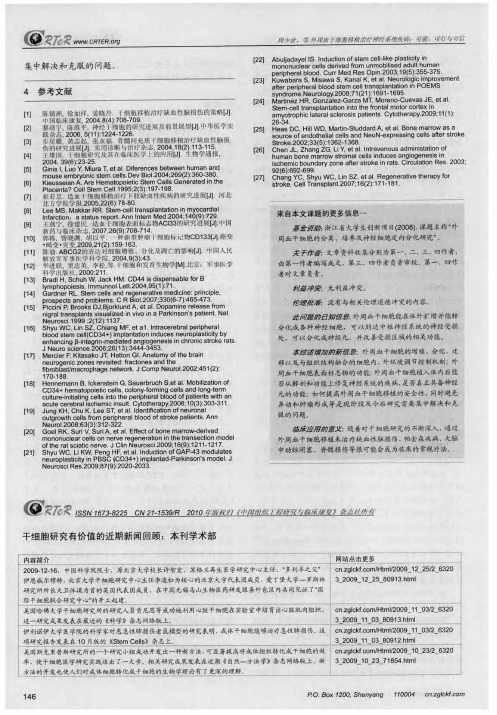
新约
’刘伤床 杂 忠
,
2
0
0
7
2
,
6
(9
):7
0
8
—
7
14
郫栋 ,
訾晓渊,
Ⅲ 以 r、
种 新 ’刚 t} 瘤 l f_111Ijc=l 标 记 物C D l 3 3 【J 】癞 变
畸变
突
变
2
,
0
0
9
2
,
1 (2
):1 5
9
—
16
3
.
陈 劬 A B C G 2 的 托达对 卸I胞 增 破 、 分化 技 凋 I、 :的 影 响 【J 1 t p l舅 人 【t
坩髓 问充质
1 细胞移植治疗 缺 血性脑损
伤 的 研 究进 展 【J 】. ’典用 诊 断
‘j
治疗杂忐 ,
2
004
1
,
8
(2
):1 1 3 -
115
l 雄 ㈦ 下 细 胞 研 究 及 其们 I“眯 医 学 l i f内心 用 [J ] 小 物 学通 报 ,
2 0 0 4 , 3 9 f 6 ) :2 3 — 2 5 .
p e n h a n c }n g — in t 6 }g r j n — m e d ja t e d a n g io g e n e s js j n c h r lo n jc s t r o k e r a f s
J
Ne u ro
s
c
ie
nc
e
2006
.
:2 6 ( 1 3 ):3 4 4 4 —
n b r o b Ia s t /m a c r o p h a q e n e t w o r k J C o m p N e u r o I 2 0 0 2 :4 5 1 (2 ):
《2024年FADS2通过影响脂质代谢通量调控干细胞多能性》范文
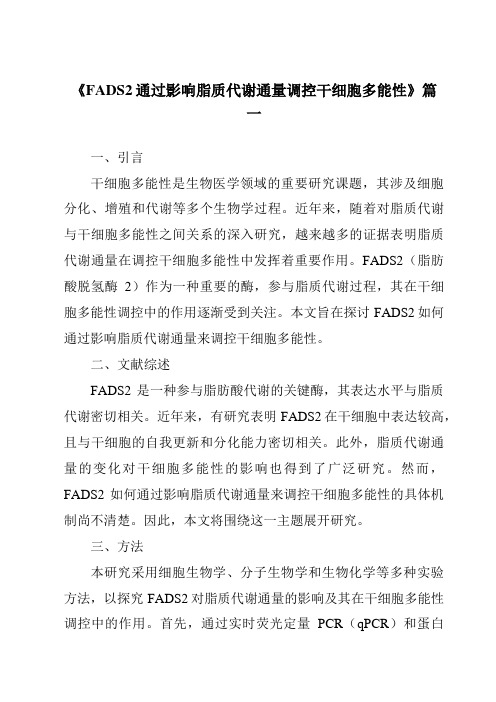
《FADS2通过影响脂质代谢通量调控干细胞多能性》篇一一、引言干细胞多能性是生物医学领域的重要研究课题,其涉及细胞分化、增殖和代谢等多个生物学过程。
近年来,随着对脂质代谢与干细胞多能性之间关系的深入研究,越来越多的证据表明脂质代谢通量在调控干细胞多能性中发挥着重要作用。
FADS2(脂肪酸脱氢酶2)作为一种重要的酶,参与脂质代谢过程,其在干细胞多能性调控中的作用逐渐受到关注。
本文旨在探讨FADS2如何通过影响脂质代谢通量来调控干细胞多能性。
二、文献综述FADS2是一种参与脂肪酸代谢的关键酶,其表达水平与脂质代谢密切相关。
近年来,有研究表明FADS2在干细胞中表达较高,且与干细胞的自我更新和分化能力密切相关。
此外,脂质代谢通量的变化对干细胞多能性的影响也得到了广泛研究。
然而,FADS2如何通过影响脂质代谢通量来调控干细胞多能性的具体机制尚不清楚。
因此,本文将围绕这一主题展开研究。
三、方法本研究采用细胞生物学、分子生物学和生物化学等多种实验方法,以探究FADS2对脂质代谢通量的影响及其在干细胞多能性调控中的作用。
首先,通过实时荧光定量PCR(qPCR)和蛋白质印迹(Western Blot)等方法检测不同类型细胞中FADS2的表达水平;其次,利用细胞培养和基因编辑技术(如CRISPR/Cas9)对FADS2进行敲除或过表达,观察细胞脂质代谢通量的变化;最后,通过细胞增殖、分化等实验评估FADS2对干细胞多能性的影响。
四、结果与讨论1. FADS2表达与脂质代谢通量的关系本研究发现,在干细胞中FADS2的表达水平较高,且与脂质代谢通量密切相关。
通过对FADS2进行敲除或过表达后,发现细胞内脂质代谢通量发生明显变化。
具体表现为敲除FADS2后,细胞内脂肪酸合成减少,而敲除后恢复的野生型细胞则恢复正常的脂肪酸合成;过表达FADS2则促进脂肪酸合成和降解。
这些结果表明FADS2在调控脂质代谢通量中发挥重要作用。
高校学生寝室自动喷水灭火系统布置
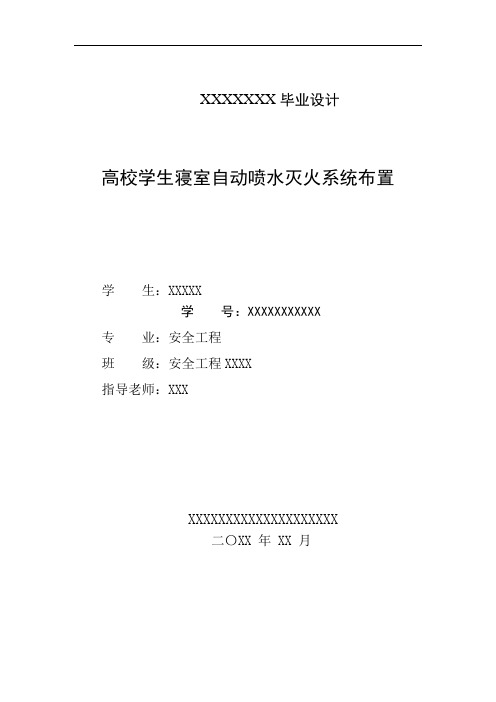
XXXXXXX毕业设计高校学生寝室自动喷水灭火系统布置学生:XXXXX学号:XXXXXXXXXXX专业:安全工程班级:安全工程XXXX指导老师:XXXXXXXXXXXXXXXXXXXXXXX二〇XX 年 XX 月摘要本文以高校寝室为对象,对如何在高校寝室中设置自动喷水灭火系统进行了研究。
近年来高校火灾的频频发生,严重威胁到了高校学生的安全和高校财产的安全。
自动喷水灭火系统是目前世界上公认的最有效、普及率最高的消防设施,它是一种能够在发生火灾时,及时探测到环境温度的骤变,自动打开喷头进行喷水灭火的装置,因为其具有监测火灾发生,及时出水控制火灾,自动报警等优点,广泛运用于各类建筑当中。
本文就以高校寝室为研究对象,分析并设计自动喷水灭火系统,根据《自动喷水灭火系统设计规范》介绍了自动喷水灭火系统中各组件的设置以及工作原理,介绍了自动喷水灭火系统喷头的选型以及配水管、管网的布置要求,水力计算部分详细介绍了作用面积法,并采用作用面积法进行了水力计算。
本文的设计目的是在高校寝室中发生火灾的时候,将火灾第一次时间抑制在初始阶段,能够及时地采取有效的灭火措施,保障学生们的人身安全,最大限度地减少火灾造成的生命和财产损失。
关键词:自动喷水灭火系统;喷头;水力计算;作用面积法AbstractThis thesis researched how to set up automatic sprinkler system in the Universities recent years,fires in the Universities is occur frequently and it have been a serious threat to the University student`s lives and system is a fire facilities which is world recognized the most effective and have the highest `s a system which can detected the fires in time and automatically open the nozzle sprinkle and also issued a fire alarm when of sprinkler system have automatic sprinkler,fire detection,automatic alarm and control fires in beginning,it has been widely used in building fire.In this thesis,the purpose of the design of automatic sprinkler system against the analysis of the Universities to’Design specifications of the automatic sprinkler system’,this thesis introduced how to select sprinkler nozzle and installation requirements of pipeline and pipe the hydraulic calculation this thesis introduced the method of active area,and use this method to calculate thesis in order to discover the fire in the beginning,and suppress the fire in the initial stages,to minimize loss of life and property caused by fires.Key words:automatic sprinkler system;sprinkler nozzle;hydraulic calculation;the method of active area目录第一章绪论 (3)研究背景 (3)国内外研究现状 (3)国内研究现状 (3)国外研究现状 (4)研究目的 (5)研究内容 (5)第二章自动喷水灭火系统 (7)系统类型 (7)湿式自动喷水灭火系统 (7)干式自动喷水灭火系统 (9)预作用自动喷水灭火系统 (10)研究对象 (10)系统组件 (11)喷头 (11)报警阀组 (12)水流指示器 (13)压力开关 (13)末端试水装置 (13)供水系统 (13)第三章自动喷水灭火系统设计 (15)喷头 (15)喷头选型 (15)喷头的保护面积 (15)喷头布置 (16)管网布置 (19)小结 (20)第四章水力计算 (22)作用面积法 (22)计算过程 (24)小结 (31)第五章结论及展望 (32)结论 (32)展望 (32)参考文献 (34)致谢 (36)第一章绪论研究背景经济的迅速发展使社会对人才的需求日益加大,各大高校为了满足社会的需求,逐年扩招,高校寝室人员密集,电器繁多,加之学生安全意识不足,违规使用大功率电器,造成很大的火灾隐患,近年来中外高校宿舍火灾事故频频发生,例如2008年上海商学院徐汇校区因学生使用“热得快”烧水引起火灾导致4人死亡,2008年中央美术学院发生火灾导致100多间寝室被烧毁。
数字化转型能否提升农业企业绩效

数字化转型能否提升农业企业绩效目录一、内容描述 (2)1.1 背景介绍 (2)1.2 研究意义 (4)二、数字化转型概述 (5)2.1 数字化转型的定义 (6)2.2 数字化转型的特征 (7)2.3 数字化转型的分类 (8)三、农业企业数字化转型的现状 (9)3.1 农业企业数字化转型的背景 (10)3.2 农业企业数字化转型的挑战 (11)3.3 农业企业数字化转型的机遇 (12)四、数字化转型对农业企业绩效的影响分析 (13)4.1 提高运营效率 (15)4.2 降低运营成本 (16)4.3 提升产品质量 (17)4.4 增强市场竞争力 (18)4.5 促进创新和可持续发展 (19)五、案例分析 (21)5.1 国内外成功案例介绍 (22)5.2 案例分析 (23)六、结论与建议 (24)6.1 结论总结 (26)6.2 对农业企业的建议 (27)七、研究展望 (29)7.1 研究局限 (30)7.2 未来研究方向 (31)一、内容描述数字化转型在农业企业中的定义与内涵。
阐述数字化转型的基本概念,及其在农业企业中的具体应用,包括数字化技术在农业生产、管理、营销等方面的应用。
数字化转型对农业企业绩效的影响。
分析数字化转型如何影响农业企业的生产效率、成本控制、市场竞争力等方面,探讨数字化转型带来的潜在优势和挑战。
农业企业数字化转型的成功案例。
通过具体案例分析,展示数字化转型在农业企业中的实际应用效果,为其他农业企业提供借鉴和参考。
数字化转型过程中农业企业面临的挑战与问题。
分析农业企业在数字化转型过程中可能遇到的困难,如技术瓶颈、人才短缺、资金投入等问题,并提出相应的解决方案和建议。
展望未来农业企业数字化转型的发展趋势。
预测农业企业在数字化转型方面的未来发展方向和趋势,为农业企业的战略规划提供指导。
1.1 背景介绍随着科技的快速发展,数字化转型已成为各行各业寻求发展的重要趋势。
农业企业作为国民经济的重要组成部分,其数字化转型对于提高生产效率、优化资源配置、增强市场竞争力等方面具有重要意义。
修复大脑 造福人类——记暨南大学粤港澳中枢神经再生研究院教授陈功及其团队

修复大脑 造福人类——记暨南大学粤港澳中枢神经再生研究院教授陈功及其团队 李 莉 肖贞林大脑是人体最复杂、最精密的器官,交织着无数细密的血管和大约1000亿个神经元细胞,一旦脑疾病发生,神经元死亡后便很难再生,大脑功能也由此受损。
脑疾病离我们并不遥远,脑中风、老年痴呆症、帕金森综合征、亨廷顿舞蹈症等都属于脑疾病的范畴。
在中国,有几千万病人正承受着脑疾病带来的痛苦,而全世界的患者数量,已达到数亿。
然而,即便现代医学水平发展至今,疗效显著的药物却寥寥无几。
暨南大学粤港澳中枢神经再生研究院教授陈功带领团队研发的革命性新技术——大脑原位神经再生技术,为脑疾病患者带来了新希望。
此项技术是人类攻克脑损伤与脑疾病征途的一个重大突破,其将大脑内应激型胶质细胞,在原位直接转化为功能性神经元,从而恢复患者的行为能力,有望治疗脑损伤、脑中风、老年痴呆症和帕金森病等一系列中枢神经系统疾病。
“修复大脑,造福人类”是陈功多年来追求的梦想,大脑原位神经再生技术的开发方兴未艾,从小鼠到猴子再向着临床转化的目标迈进,陈功正带领着团队一步步接近修复大脑的梦想。
大胆做出设想:一段奇妙旅程开启在攻克脑疾病的路上,陈功已经走过了十几年的历程。
2010年,陈功在向小鼠脑内注射干细胞试图再生神经元受挫之后,就萌发了利用脑内已经存在的胶质细胞进行原位转分化为神经元的想法。
经过3年的探索,2013年年底,还是美国宾夕法尼亚州立大学生物系维恩·魏勒曼冠名主任教授的陈功带领团队首次在线发表了运用神经转录因子NeuroD1成功将老年痴呆症小鼠模型的脑内胶质细胞原位高效转化为功能性神经元的成果,产生了深远的国际影响。
这项转分化的研究是受到2012年诺贝尔生理学或医学奖获得者山中伸弥 (Shinya Yamanaka)的诱导性多功能干细胞(iPSC)研究的启发。
山中伸弥运用4个转录因子成功地将皮肤细胞重编程为多功能干细胞,循着这条路,许多干细胞工作者开启了在细胞培养皿里将一种细胞转化成另一种细胞的种种尝试。
再生功能性神经元用于治疗因血流破坏引起的神经损伤[发明专利]
![再生功能性神经元用于治疗因血流破坏引起的神经损伤[发明专利]](https://img.taocdn.com/s3/m/31160e02e009581b6ad9eb3f.png)
专利名称:再生功能性神经元用于治疗因血流破坏引起的神经损伤
专利类型:发明专利
发明人:陈功
申请号:CN201880014584.4
申请日:20180228
公开号:CN110366423A
公开日:
20191022
专利内容由知识产权出版社提供
摘要:根据本发明的方面,提供了治疗有需要的个体对象中CNS中正常血流的破坏的影响的方法,其包括将治疗有效剂量的外源性NeuroD1给予正常血流已被破坏的区域。
提供了组合物,其包含:1)重组腺相关腺病毒表达载体,其包含与编码位点特异性重组酶的核酸操作性地连接的神经胶质细胞特异性启动子和2)重组腺相关腺病毒表达载体,其包括与编码NeuroD1的核酸操作性地连接的遍在启动子,其中编码NeuroD1的核酸被反转并且侧接两组位点特异性重组酶识别位点,使得重组酶的作用不可逆地反转编码NeuroD1的核酸,使得NeuroD1在哺乳动物细胞中表达。
申请人:宾州研究基金会
地址:美国宾夕法尼亚州
国籍:US
代理机构:上海专利商标事务所有限公司
更多信息请下载全文后查看。
加速科技转化,推进高校和社会经济发展——美国宾夕法尼亚州立大学的经验

Accelerating Technology Transformation, Promoting University and Social Development --The Experience of Penn State University of United States 作者: 杨珂[1,2]
作者机构: [1]教育部人文社会科学重点研究基地北京师范大学比较教育研究中心、北京师
范大学教育学院国际与比较教育研究所,100875;[2]国家环保总局宣传教育中心,100029
出版物刊名: 比较教育研究
页码: 7-11页
主题词: 美国;宾夕法尼亚州立大学;大学科技园;科技转化;大学创新力
摘要:知识经济时代,大学承担着重大责任。
大学的科研创新力在大学创新力体系中占有重要地位,而大学科技园通常是体现大学科技创新力的重要窗口。
本文介绍了美国宾夕法尼亚州立大学通过其创新园进行科技转化的一些经验,包括科技转化在宾州州立大学的发展理念、组织机构、实现模式和效果影响等,并与我国大学科技园进行比较分析,从中探讨大学科技转化的新模式和新问题,为我国大学科技创新力的提升提供借鉴。
艺术博物馆生态系统:一种新的替换模式

艺术博物馆生态系统:一种新的替换模式
Yuha Jung;刘鹏
【期刊名称】《文化艺术研究》
【年(卷),期】2013(006)002
【摘要】个人、人类社会及自然世界内部相连、相互依赖,主要通过社交网络得以完成.博物馆恰好符合这个范式,理由在于,博物馆的职员、部门、藏品、使命、观众及其他文化教育机构是相互联系、不可分割的,均受到其他因素的影响.然而,许多博物馆的运营体系等级森严,缺乏沟通和交流.其结果便是,知识与思想未能在博物馆专业人士和博物馆所在社区得以有效共享并得以更新.这些博物馆实践将多种观点排除在外,对未被充分代表的群体的利益置若罔闻.通过假定一个生态博物馆模型的渠道,本文提供了一个可供替换的博物馆管理和教育模式.该模式把博物馆看作其所在社区和社会中一分子,包罗万象并兼具生态学的诸多特征.
【总页数】13页(P152-164)
【作者】Yuha Jung;刘鹏
【作者单位】宾夕法尼亚州立大学;江苏省美术馆,南京210018
【正文语种】中文
【中图分类】J261
【相关文献】
1.一种新的基于推荐的流媒体代理缓存替换机制 [J], 胡玉琦;李晓娜
2.一种新的代理缓存替换算法 [J], 原福永;张微微
3.TOW:一种新的P2P实时流媒体缓存替换算法 [J], 胡懋智;徐恪;夏树涛;叶明江
4.一种替换了Cr^6+的底漆新配方 [J],
5.企业战略创新生态系统:一种新的竞争模式 [J], 靳洪
因版权原因,仅展示原文概要,查看原文内容请购买。
【课外阅读】美国加州6所科研机构计划联手研究干细胞

美国加州6所科研机构计划联手研究干细胞美国加利福尼亚州6所科研机构共同发起一项干细胞科研合作项目,以推动干细胞研究取得进展。
项目发起人、南加州大学干细胞和再生医学中心主任马丁·佩拉在一份声明中说,由6所科研机构发起的这一合作项目,是美国科学家在干细胞研究领域迈出的重要一步。
根据这一项目,不同学科的科研人员将进行共同培训、交流研究经验、分享科研资源及成果。
声明说,干细胞研究在医疗领域有着广阔的应用前景,但要使干细胞研究取得重大突破,各领域科学家需要精诚合作。
据介绍,除南加州大学外,参加这一项目的其他5家机构分别是洛杉矶儿童医院、加利福尼亚大学圣巴巴拉分校、
加州理工学院、豪斯耳科研究中心和美国希望之城国家医疗中心。
尽管布什政府以干细胞研究会破坏伦理道德为由限制这方面的研究,但加州却与美国联邦政府的政策背道而驰。
维生素与丙型肝炎病毒的关系研究

维生素与丙型肝炎病毒的关系研究
陈功;邓涛
【期刊名称】《医学研究杂志》
【年(卷),期】2017(046)002
【摘要】全球约有1.7亿人感染丙肝病毒,严重威胁着人类的身心健康.大量的观察性及干预性研究发现在丙肝患者血清中缺乏多种维生素和微量元素,如维生素A、B12、D、E、锌.近年来研究者发现维生素与丙肝病毒存在密切的关系,本文将就这几种维生素对HCV的影响及其可能的作用机制分别进行阐述.通过维生素与丙肝病毒的关系研究,为丙肝病毒的补充治疗提供理论基础.
【总页数】3页(P162-164)
【作者】陈功;邓涛
【作者单位】430060 武汉大学人民医院消化内科;430060 武汉大学人民医院消化内科
【正文语种】中文
【中图分类】R512.6
【相关文献】
1.丙型肝炎病毒感染者外周血25-羟基维生素D测定与分析 [J], 罗燕玲;万德胜;谢小燕;周晓玲
2.丙型肝炎病毒感染与维生素D缺乏研究进展 [J], 蔺朝妮
3.多囊卵巢综合征与血清维生素D和维生素D受体基因多态性的关系研究 [J], 潘小红;杨春燕;王小红;李采霞;吴开玲
4.孕妇血清维生素A维生素E的水平与妊娠周期高危因素以及孕妇年龄的关系研究 [J], 梁乐光;叶玉娥;杨泽敏;黄惠东;郑晓如
5.维生素D和慢性丙型肝炎病毒感染的关系 [J], 张永贵;左丽娟;王帅;王江滨;徐严因版权原因,仅展示原文概要,查看原文内容请购买。
国内外体力活动影响因素的研究进展——基于社会生态学视角的分析

国内外体力活动影响因素的研究进展——基于社会生态学视角的分析王东敏;Nancy Morrow-Howell;陈功【期刊名称】《河北体育学院学报》【年(卷),期】2017(031)001【摘要】通过梳理和分析国内外近30年有关体力活动影响因素的研究文献发现:随着时间的推移,职业、心脏病风险、婚姻状况、肥胖、家庭支持、医生对病人的康复运动建议等与体力活动的相关性越来越强;儿童时期自评健康状况、过去的健身行为、吸烟逐渐成为研究领域的新增变量;体力活动水平的提高不仅需要考虑个体的行为选择,还要充分关注社会环境、社区物质环境和自然环境的综合影响.今后研究中应加强对生命历程中体力活动跟踪的纵向研究,探索影响体力活动的决定性因素,实现有针对性的体力活动干预和健康促进.【总页数】8页(P46-53)【作者】王东敏;Nancy Morrow-Howell;陈功【作者单位】北京大学体育教研部,北京100871;美国圣路易斯华盛顿大学老年研究中心,美国60031;北京大学人口研究所,北京100871【正文语种】中文【中图分类】G804【相关文献】1.西方国家青少年体力活动相关研究述评--基于社会生态学视角的分析 [J], 韩慧;郑家鲲2.国内外社会化媒体的研究进展比较——基于2009-2013年期刊论文的计量分析[J], 李武;章隐玉;卢振波3.基于健康信念模式的冠心病患者体力活动影响因素分析 [J], 田伟; 吴宁4.社会认知理论视角下青少年体力活动影响因素分析 [J], 刘建秀; 尚博睿; 尹懿; 杨明; 曾牧川; 张耀; 马新东5.社区户外建成环境对老年人体力活动影响机制研究进展及启示——基于社会生态学视角 [J], 陈云凤;李玲玲因版权原因,仅展示原文概要,查看原文内容请购买。
最新重组SARS冠状病毒S蛋白的原核表达研究
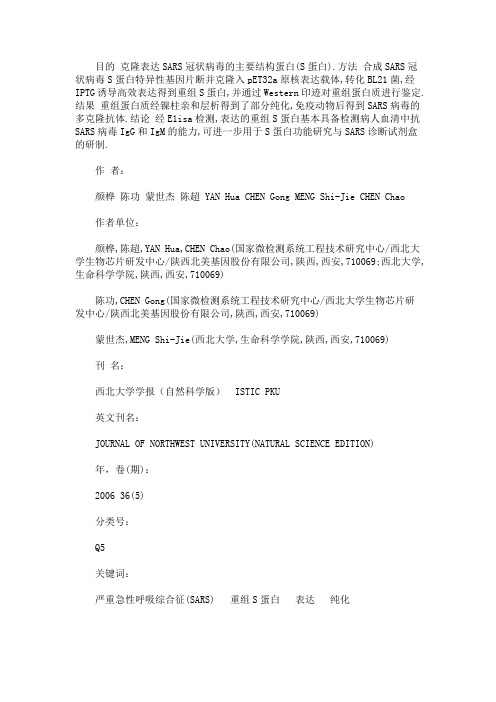
目的克隆表达SARS冠状病毒的主要结构蛋白(S蛋白).方法合成SARS冠状病毒S蛋白特异性基因片断并克隆入pET32a原核表达载体,转化BL21菌,经IPTG诱导高效表达得到重组S蛋白,并通过Western印迹对重组蛋白质进行鉴定.结果重组蛋白质经镍柱亲和层析得到了部分纯化,免疫动物后得到SARS病毒的多克隆抗体.结论经E1isa检测,表达的重组S蛋白基本具备检测病人血清中抗SARS病毒IgG和IgM的能力,可进一步用于S蛋白功能研究与SARS诊断试剂盒的研制.
作者:
颜桦陈功蒙世杰陈超 YAN Hua CHEN Gong MENG Shi-Jie CHEN Chao
作者单位:
颜桦,陈超,YAN Hua,CHEN Chao(国家微检测系统工程技术研究中心/西北大学生物芯片研发中心/陕西北美基因股份有限公司,陕西,西安,710069;西北大学,生命科学学院,陕西,西安,710069)
陈功,CHEN Gong(国家微检测系统工程技术研究中心/西北大学生物芯片研发中心/陕西北美基因股份有限公司,陕西,西安,710069)
蒙世杰,MENG Shi-Jie(西北大学,生命科学学院,陕西,西安,710069)
刊名:
西北大学学报(自然科学版) ISTIC PKU
英文刊名:
JOURNAL OF NORTHWEST UNIVERSITY(NATURAL SCIENCE EDITION)
年,卷(期):
2006 36(5)
分类号:
Q5
关键词:
严重急性呼吸综合征(SARS) 重组S蛋白表达纯化。
- 1、下载文档前请自行甄别文档内容的完整性,平台不提供额外的编辑、内容补充、找答案等附加服务。
- 2、"仅部分预览"的文档,不可在线预览部分如存在完整性等问题,可反馈申请退款(可完整预览的文档不适用该条件!)。
- 3、如文档侵犯您的权益,请联系客服反馈,我们会尽快为您处理(人工客服工作时间:9:00-18:30)。
美国宾夕法尼亚州立大学陈功教授学术报告会
报告题目:In Vivo Reprogramming: Reversing Glial Scar Back To Neural Tissue For Brain Repair
报告人:Gong Chen
报告时间:2015年5月29日(星期五) 11:00 - 12:30
报告地点:北京大学医学部神经科学研究所会议室(中心楼)
主持人:于常海教授
陈功教授简介:1987 年毕业于上海复旦大学,随后师从中国科学院上海生理研究所冯德培院士攻读博士学位。
之后先后在耶鲁大学(Dr. Anthony van den Pol) 和斯坦福大学(Dr. Richard Tsien) 进行博士后研究。
现任宾夕法尼亚州立大学生物学系维恩·魏勒曼冠名主任教授(Verne M. Willaman Chair in Life Sciences)。
研究兴趣主要集中于大脑损伤后的修复和神经退行性疾病的治疗方面,最近发表的脑内在体胶质细胞转化为功能性神经元的工作(Cell Stem Cell, 2014)在世界范围内引起巨大反响,可能给脑疾病的治疗带来一场革命。
先后在Nature ,Cell ,Cell Stem Cell, Nature Communications, PNAS,Neuron, Nature Neuroscience 等世界顶尖杂志发表数十篇高水平论文,并获得Alzheimer’s Association Zenith Fellows Award等多项
(In vivo 奖励和资助。
2014 年11月在华盛顿主持了世界上首次干细胞领域内“在体细胞转化”reprogramming)的专题报告会,参会者达800多人,标志着一个新的领域诞生。
演讲摘要:Glial scar is a common pathological hallmark that is widely associated with brain injury, stroke, glioma, and neurodegenerative disorders such as Alzheimer’s disease. Reactive glials initially exert neuroprotective effects but later form glial scars to inhibit neuronal growth. Currently, there is no effective way to reverse glial scars back to normal neural tissue. We have recently developed an innovative in vivo reprogramming technology to directly convert reactive glial cells into functional neurons inside the mouse brain (Guo et al., Cell Stem Cell, 2014). This is achieved through in vivo expression of a single neural transcription factor NeuroD1 in the reactive astrocytes in injured mouse brain or model animals for Alzheimer’s disease. Our in vivo direct cell conversion technology will not only reduce the number of reactive astrocytes, but also generate new neurons simultaneously at the injury site, making it possible for the first time to
reverse glial scar back to neural tissue. Such internal trans-differentiation method will avoid immunorejection and tumorigenesis associated with conventional stem cell therapy. We have further demonstrated that cultured human astrocytes can be directly converted into functional neurons by small molecules, suggesting that our cell conversion technology may be developed into drug therapies for human brain repair.
This project was supported by grants from NIH and PSU Stem Cell Endowment Fund.。
